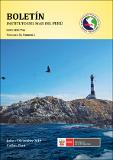Por favor, use este identificador para citar o enlazar este ítem:
https://hdl.handle.net/20.500.12958/3396| Título : | Validación de información satelital de temperatura superficial del mar con registros in situ dentro de las 60 millas del mar del Perú |
| Otros títulos : | Validation of satellite sea surface temperature information with in situ records within 60 miles of the Peruvian sea |
| Autor : | Quispe, Daniel Gutiérrez Aguilar, Dimitri Vásquez Espinoza, Luis |
| Palabras clave : | TSM satelital;Validación temperatura |
| Fecha de publicación : | 2019 |
| Editorial : | Instituto del Mar del Perú |
| Citación : | Bol Inst Mar Perú. 34(2) 2019: p. 392-405 |
| Citación : | Boletín IMARPE 34(2), 2019; |
| Resumen : | Las condiciones
térmicas del sistema costero peruano se monitorean a través de registros in situ e información satelital de
diferentes sensores que incluyen post-procesamiento. Se identificaron con parámetros de error y dispersión
las bases de información satelital que tuvieron mayor aproximación a los registros in situ, y evaluaron, en
términos de error, las estimaciones de TSM en franjas adyacentes a la costa para ver el efecto de ubicación
costa-océano. La información satelital se tomó de las bases AVHRR, MW, MW-IR, NAVOCEANO, MUR y
OSTIA y los registros in situ de los cruceros de investigación y monitoreo en secciones-puntos fijos efectuados
entre los años 2014 y 2016. En las franjas de 10-20 y 20-30 mn frente a la costa, se encontró que frente a
los registros de TSM de cruceros, la base OSTIA en promedio tuvo menor error (RMSD = 0,625) y menor
dispersión (SD = 1,855), lo que indica mayor exactitud y precisión; mientras que frente a los registros en
secciones-puntos fijos, MUR presentó menor error (RSMD = 0,715) y OSTIA menor dispersión (SD = 1,948)
indicando, respectivamente, mayor exactitud y precisión que las demás bases satelitales. El gradiente costaocéano,
en la mayoría de bases de información satelital, presentaron estimaciones de TSM con mayor nivel
de error en franjas cercanas a la costa (0-10 mn) y menor error en franjas más distantes (30-60 mn), el error
disminuyó de costa a océano tanto de registros en cruceros (promedio MAE de 0,96 a 0,26), como de registros
en secciones-puntos fijos (promedio MAE de 1,06 a 0,41). OSTIA y MUR presentaron estimaciones de TSM
con mejor aproximación a la TSM in situ. ABSTRACT: In situ recordings and satellite information from different sensors including post-processing are used to monitor the thermal conditions of the Peruvian coastal system. The satellite information databases, which had a greater approximation to in situ records, were identified with error and dispersion parameters and the SST estimates in strips adjacent to the coast were evaluated in terms of error to see the effect of the coast-to-ocean location. Satellite information was taken from the AVHRR, MW, MW-IR, NAVOCEANO, MUR, and OSTIA databases and in situ records were taken from research and monitoring cruises in fixed-point sections conducted between 2014 and 2016. It was found that compared to records in cruises, the OSTIA database presented, on average, less error (RMSD=0.625) and less dispersion (SD=1.855) at distances of 10-20 and 20-30 nm offshore, indicating greater accuracy and precision, while compared to records in sections-fixed points, MUR presented less error (RSMD=0.715) and OSTIA less dispersion (SD=1.948) showing, respectively, greater accuracy and precision than the other satellite databases. In the coast-to-ocean gradient, the SST estimates for most of the satellite information databases showed a higher level of error in stripes near the coast (0-10 nm) and a lower error in more distant stripes (30-60 nm). The error decreased from coast to ocean both as opposed to records on cruises (mean MAE from 0.96 to 0.26), and as opposed to records in fixed-point sections (mean MAE from 1.06 to 0.41). OSTIA and MUR presented SST estimates with a better approximation to the in situ SST. |
| URI : | https://hdl.handle.net/20.500.12958/3396 |
| ISSN : | 04587766 |
| Aparece en las colecciones: | Boletín 34(2), 2019 |
Ficheros en este ítem:
| Fichero | Descripción | Tamaño | Formato | |
|---|---|---|---|---|
| Boletin 34(2)-7.pdf | 1,65 MB | Adobe PDF |  Visualizar/Abrir |
Este ítem está sujeto a una licencia Creative Commons Licencia Creative Commons

